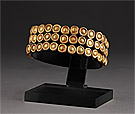Exhibition themes Burial Practices
Almost everything we know of ancient Peruvian cultures is because of the cult of the dead. Both noble and common people were interred in diverse ways. Tiers of importance—from ruling lords, priests, military leaders and retainers—can be understood through their respective accoutrements and placement in graves.
Early Chavinoid cultures of the north buried many people together, some in seated positions and others extended flat. Most were wrapped in simple cotton textiles. Only members of the elite were accompanied by gold or precious grave goods. The Paracas are known for complex mummy bundles, swathed in many luxurious cloths and accompanied by modest tools and ceramics. Vicús nobles were placed in shaft tombs, bodies wrapped, with precious ornaments alongside. Moche corpses, both male and female, were laid flat in tombs under many layers of treasure.
Lords of Sicán were buried in mummy bundles in lavish multi-level tombs, with masks, crowns, ear ornaments and jewels accompanying them into the afterlife. Bodies of women, children and servants have been found next to the noble dead, some sacrificed as offerings and others who died years before or after their lords. Chimú royalty was interred on burial platforms, tended by their heirs, inside the citadels of Chan Chan. Inca royalty was mummified, adorned and became part of annual postmortem ceremonies when their corpses were paraded around the city of Cuzco.














